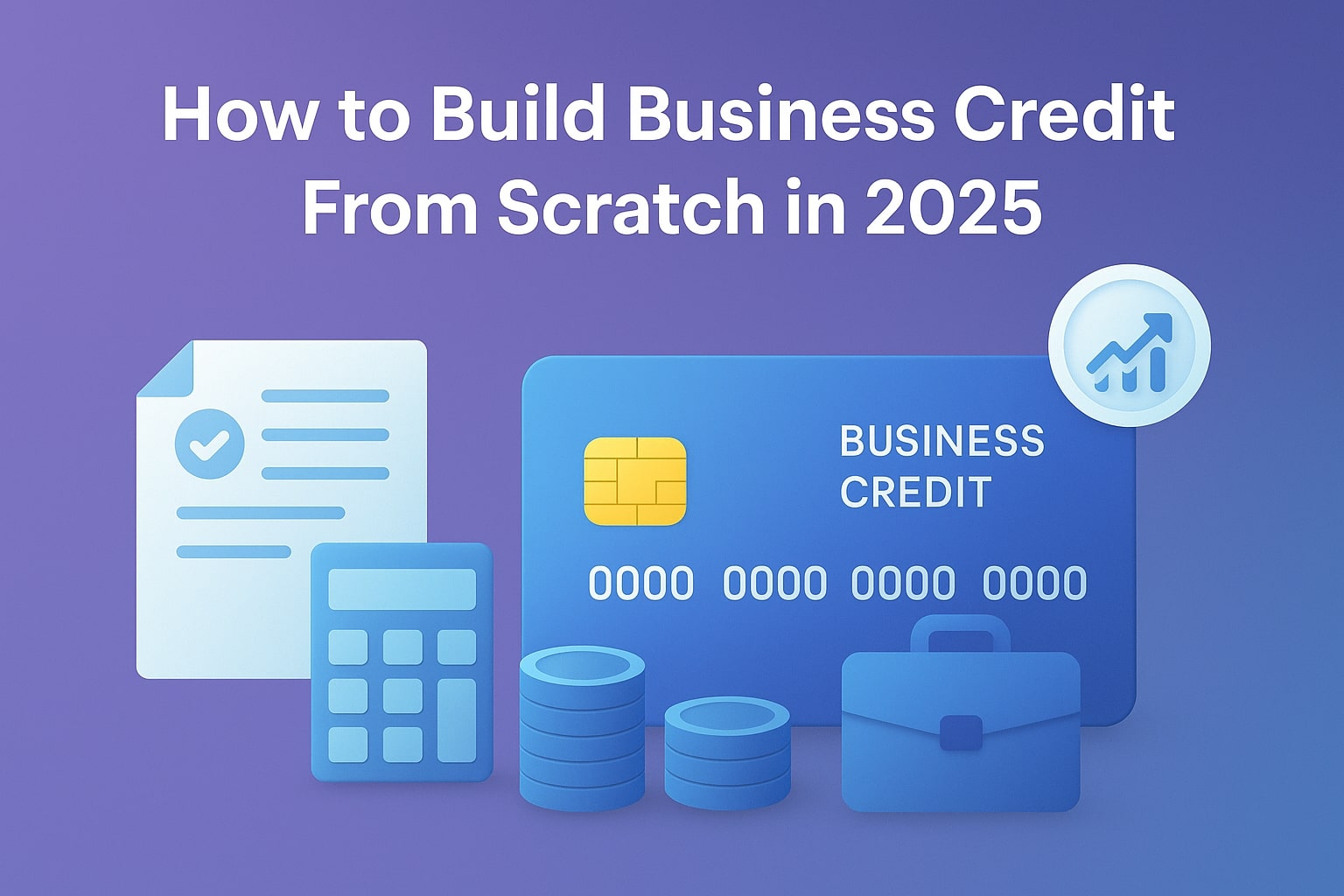
How to Build Business Credit From Scratch in 2025
In 2025, building business credit from scratch means establishing your company’s financial identity and payment history from the ground up.
By separating your personal and business finances (through steps like incorporation and obtaining an EIN) and by consistently making on-time payments on business accounts, a small business can build a positive credit profile.
A strong business credit profile unlocks financing options with better terms (loans, lines of credit, credit cards) and signals to vendors and lenders that your company is stable and trustworthy.
This guide covers every step US small business owners need – from legal setup and credit bureau registration to using tools like business credit cards and net‑30 vendor accounts – to build business credit from scratch.
Why Business Credit Matters for Small Businesses
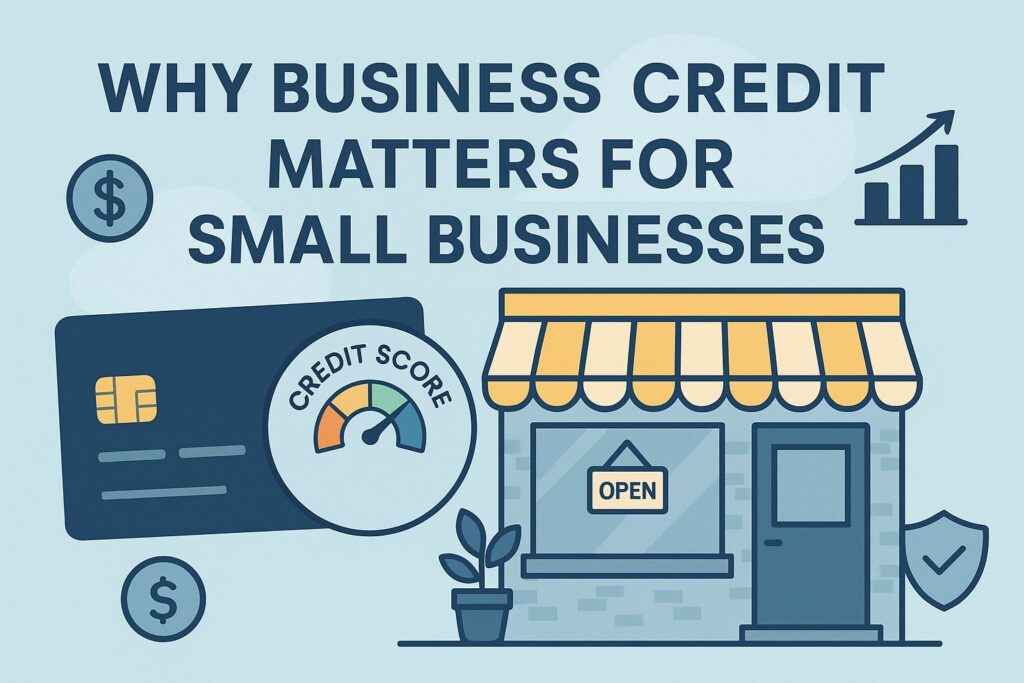
Even when a company is new, lenders and suppliers want to see creditworthiness. As the U.S. Chamber of Commerce explains, “like individuals, businesses have to establish a credit history in order to secure loans, attract partners, and get the best possible insurance rates”.
In fact, new businesses usually rely on the owner’s personal credit when first applying for loans. Establishing a separate business credit history early on creates a financial firewall: it protects personal assets and lets the business borrow based on its own track record.
Businesses with strong credit can often secure higher credit limits and lower rates. For example, one guide notes that a company with a year of positive payment history might see trade credit offers rise from $5,000 to $50,000 or more.
Building business credit “legitimizes your business,” Brex observes, because vendors and lenders see an established credit profile as a mark of stability.
In short, the best way to build business credit is to treat your company as its own financial entity from Day 1. That starts with the right legal structure and registration, then moves to opening credit‑worthy accounts that report payment history to the credit bureaus.
The steps below explain how U.S. businesses can do this in 2025 to earn a solid business credit score.
Key Differences: Business Credit vs Personal Credit
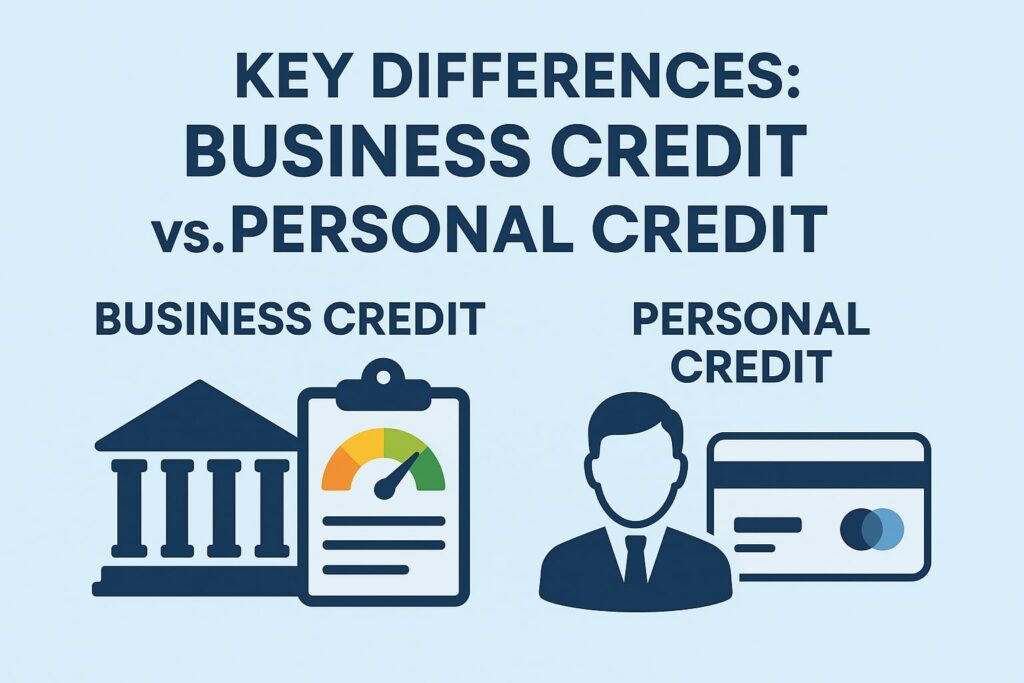
Unlike personal credit (which is tied to your Social Security number and personal history), business credit is tied to your company’s EIN (Employer Identification Number) and legal entity.
A business credit report and score (from agencies like Dun & Bradstreet, Experian, and Equifax) reflect only business-related debts and payments, not the owner’s personal finances. This separation is important.
As Brex explains, “business credit operates differently and separately. It’s tied to your business entity and EIN, not your personal Social Security number”.
That means timely payments on business loans, credit cards, and vendor accounts build your company’s credit score, just as personal payments build your individual credit score.
Conversely, personal credit missteps generally won’t damage the business’s credit once the accounts are separate.
In practice, new businesses often start with personal guarantees (for example, personal credit cards or loans) until business credit is established. But the goal is to move away from personal guarantees as soon as possible, so your business credit history stands on its own.
With a strong business credit profile, you can qualify for loans and credit lines on the merits of the business itself. This reduces personal liability: creditors will evaluate your company separately from your personal finances.
Overall, building business credit “opens doors to funding sources that don’t consider personal credit,” including SBA and commercial loans, larger credit limits, and vendor terms.
Step-by-Step: Building Business Credit from Scratch
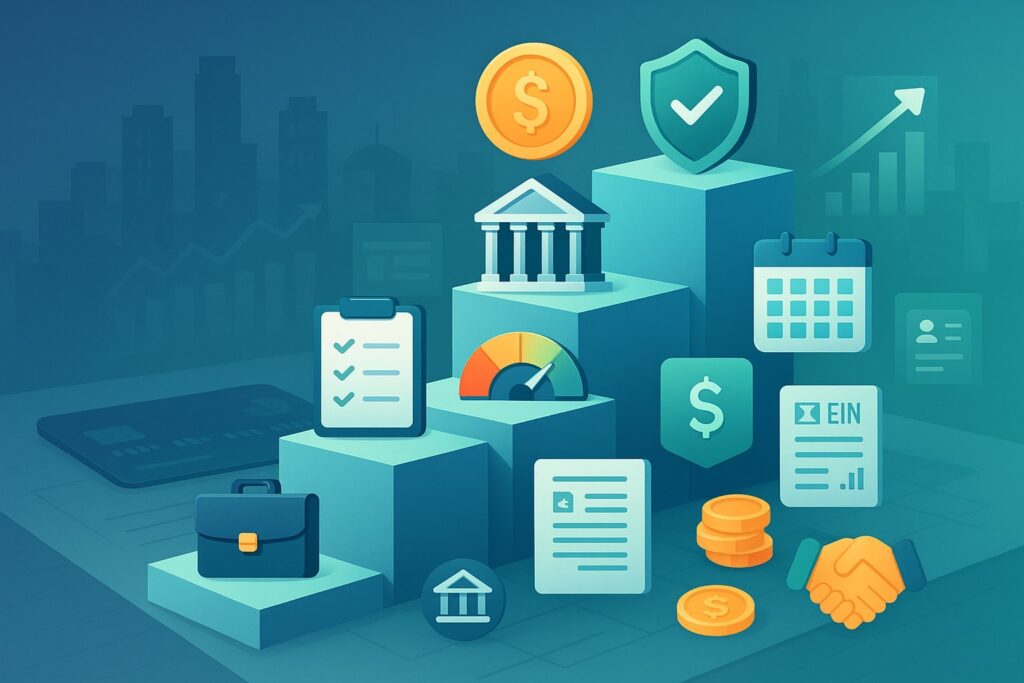
Below is a step-by-step roadmap for U.S. small businesses to build credit from the ground up. Each step includes practical actions and tools (credit bureaus, accounts, and services) that report to the business credit agencies.
1. Form a Separate Legal Business Entity
First and foremost, incorporate or form an LLC (or other corporation) rather than operate as a sole proprietorship. By doing so, your business becomes a legal entity distinct from the owner. This legal separation is crucial for separating credit histories.
For example, Wolters Kluwer notes that “incorporating a business or forming an LLC creates a business that is legally separate from the owner(s)”. An LLC or S-corp also provides personal asset protection, but in terms of credit, it ensures that business debts are recorded under the business.
Some lenders and suppliers will only extend credit to incorporated entities and not to sole proprietorships. Even if you have some credit history as a sole proprietor, you may have to restart credit-building under the new entity.
Likewise advises that “LLC or corporation helps separate your personal and business finances and can be very helpful for building credit. Some suppliers and lenders will not work with sole proprietorships”.
Checklist:
- Choose and register a business structure (LLC, S-Corp, or C-Corp) with your state.
- Obtain any required state licenses or local business permits.
- Use your formal business name consistently on all documents.
2. Obtain an EIN and DUNS Number
Next, get the unique tax and identifier numbers your business needs:
- EIN (Employer Identification Number): This is the business equivalent of a Social Security number. You can apply for an EIN free on the IRS website (no need to pay third parties).
Your EIN will be used on tax filings, bank accounts, and credit applications. According to Brex, “This nine-digit [EIN] number becomes the primary identifier for your business credit profile across all three major business credit bureaus”.
In other words, your EIN is key to linking all your accounts and tradelines to the business credit reports.
Always use the EIN instead of your SSN when applying for business credit or registering the business. The U.S. Chamber also notes that an EIN is needed to apply for business credit accounts. - D-U-N-S Number (DUNS): Issued by Dun & Bradstreet (D&B), the DUNS number is a unique 9-digit identifier for your company. It’s free to register for a DUNS on D&B’s website.
Some government contracts and large corporate clients require a DUNS number before working with you. As the Chamber points out, “If you decide to apply for government contracts, as well as certain grants or loans, you will need to submit a DUNS number”.
In practice, having a DUNS also kickstarts your D&B credit file. Get your DUNS early: once you have it, encourage suppliers to report payments to D&B so your credit begins to build.
Important: Your EIN and DUNS essentially identify your business to the credit bureaus. Be sure these numbers are on all your business credit accounts so that your payment history is tied to the correct profiles.
3. Open a Dedicated Business Bank Account and Establish Financial Identity
Now that you have your legal entity and identifiers, establish your business’s financial footprint:
- Business Bank Account: Open a commercial checking account in the business’s legal name, using the EIN. This is a critical step in “keeping your business and personal expenses separate,” as noted by Brex.
All business income and expenses should flow through this account. Over time, a healthy banking history (positive balances, timely payment of expenses) can bolster your creditworthiness. Lenders often request bank statements, so consistent use of your business account is essential. - Business Phone and Address: In addition to bank separation, use a business phone number and address. Nav recommends getting a dedicated business number (landline or VoIP) listed in a directory to add legitimacy.
Wolters Kluwer also suggests having a business phone listing in the directory so it can be found. Make sure your business address (even if virtual) and name are listed consistently on your website, Google My Business, and local directories.
These details help credit agencies validate your business’s existence through public records.
By the end of this step, your business should have: (a) a separate bank account, (b) a business phone number, and (c) consistent business contact information. These signal legitimacy to lenders and prepare you for credit applications.
4. Register Your Business with the Credit Bureaus
For your new business credit profile to exist, you need to register it (or simply let bureaus create a file when you get credit accounts). Key steps:
- Dun & Bradstreet (D&B): If you signed up for a DUNS number in Step 2, D&B will create a credit file for your business. You can then use D&B’s free CreditSignal service to watch for updates.
D&B is widely used for business credit – in fact, “most businesses primarily use D&B for business credit reporting,” since it issues the well-known PAYDEX score. - Experian Business: To get an Experian business credit report, you often need at least one tradeline (such as a credit card or vendor account) that reports there.
Experian has its own identifiers and credit score (Intelliscore). You don’t “apply” the same way as DUNS; usually opening a credit card (Step 6) triggers an Experian file. - Equifax Business: Similar to Experian, Equifax will compile a credit report once there is business activity (credit lines or loans) associated with your EIN. Equifax offers scores like the Payment Index and Business Risk Score.
- TransUnion (TU): TransUnion has a commercial credit database, though it’s less commonly referenced by lenders for small business (D&B, Experian, Equifax are the big three).
Wolters Kluwer still recommends opening a file with Experian, Equifax, and TransUnion. In practice, most lenders will check D&B, Experian, and Equifax.
To jumpstart your file, some companies let you submit your EIN to create a tradeline. For example, Nav Prime (a paid service) can add tradelines across bureaus, or you could purchase a small Business Services account with a vendor that will begin reporting.
But even without that, once you start using credit cards or vendor lines (next steps), the bureaus will take notice and build your report.
Summary: Ensure your business has an official presence with D&B, and get at least some activity reported to Experian and Equifax by setting up accounts in your company’s name.
Building Credit Through Accounts and Payments
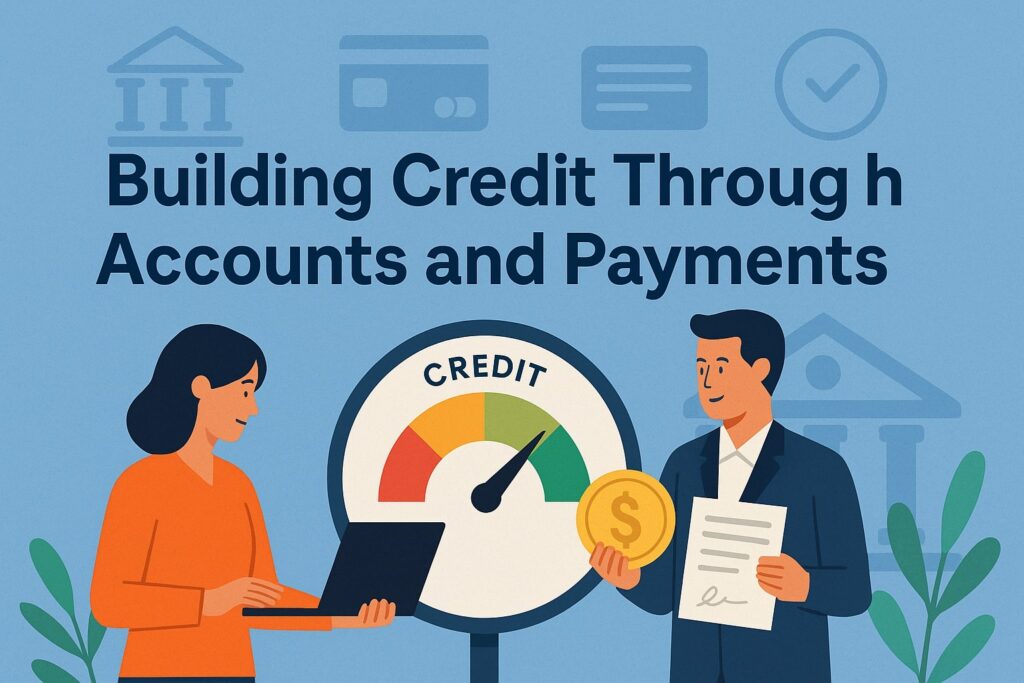
With the foundation set, the next steps involve obtaining accounts that report to the business credit bureaus and using them wisely. Each on-time payment adds to your company’s credit history.
5. Obtain a Business Credit Card (or Charge Card)
One of the fastest ways to build business credit is with a business credit card that reports to the bureaus. Many banks and fintechs offer business cards; here’s how to use them effectively:
- Choose a card that reports to business bureaus. Not all cards report business activity. Some may only report to personal credit unless you have an EIN-only product.
Look for cards (or corporate charge cards) that explicitly report to business credit agencies. For example, Brex and similar providers have business cards that no personal guarantee is needed and report payments to the major bureaus. - Avoid relying on personal credit. If possible, apply with your EIN and avoid personal guarantees. As Brex advises, applying for an EIN-only business card (with no personal liability) helps keep your personal credit separate.
However, many startup-friendly cards (like those from banks) may still require a personal guarantee. If so, know that D&B warns: such personally-guaranteed cards might not build your business credit because the creditor is really banking on your personal credit. - Pay on time and in full. Once you have a business card, treat it like a building tool. Pay off the balance in full each month or keep utilization well below 30%, as you would for personal credit.
On-time payments to a business card will be recorded as trade experiences and boost your business credit scores. The U.S. Chamber highlights that paying off the card in full and on time is one of “the best tools for building business credit”. - Watch utilization. Just as with personal credit, maxing out a business card can hurt your credit scores. Keep balances low relative to limits; if possible, pay off early. Manage routine expenses (supplies, travel, software) on the card, but always meet due dates.
- Use the card for varied expenses. Having a credit card adds a “banking” tradeline. It also helps establish payment history if used for different vendors. Some business cards come with expense management tools which can aid budgeting and timely payments.
Example cards: Major issuers (Chase Ink, Capital One Spark, American Express Blue Business, etc.) have business cards. Fintech options include Brex, Ramp, Divvy, and Capital on Tap, some of which allow no or low credit requirements.
(We aren’t endorsing specific products, but these are examples.) Choose one that matches your needs, but remember: pay diligently so the reporting goes positively onto your business’s credit file.
6. Use Vendor Credit (Net-30 Terms) to Establish Tradelines
Traditional “trade credit” with suppliers is another excellent way to build credit. Many vendors offer net-30 terms (you get 30 days to pay after receiving goods/services). If the vendor reports your account to the credit bureaus, those payments strengthen your business credit.
- Net-30 Accounts: A number of vendors cater to new businesses by offering net-30 accounts with relatively easy approval (some require no credit check). Popular examples include:
- Grainger (industrial supplies) – a go-to for factories, restaurants, etc. Its net-30 terms have no personal credit check, and Grainger reports to all three major bureaus (Dun & Bradstreet, Experian Business, and Equifax Business).
- Quill (office supplies) – offers a broad range of office products. Quill reports to Experian, Equifax and Dun & Bradstreet, which is relatively rare and very helpful.
- Uline (shipping and packaging) – sells boxes, packaging and shipping supplies. Uline offers net-30 on approval and reports payments to Experian and Equifax (and also D&B).
- Home Depot Pro – for construction or maintenance businesses, Home Depot’s business account lets you pay within 30 days. It reports to all three bureaus.
- Crown Office Supplies – an online office supply store. Crown reports to all three bureaus (Equifax, Experian, and D&B) on net-30 payments.
- Coast to Coast Office Supply – supplies business essentials. It offers net-30 terms and reports to Experian Business.
- Amazon Business – offers a “Business Line of Credit” (net-30 style) through Amazon’s Business program. Amazon reports business purchases to Dun & Bradstreet and often to Experian.
- Wise (formerly TransferWise) – for cross-border payments, offers net-30 accounts and reports to Experian and Equifax.
- And more: Other net-30 vendors include companies like Grainger, Uline, Unimark (printing), and others. Some industry-specific suppliers also offer trade terms.
- Grainger (industrial supplies) – a go-to for factories, restaurants, etc. Its net-30 terms have no personal credit check, and Grainger reports to all three major bureaus (Dun & Bradstreet, Experian Business, and Equifax Business).
- How to get net-30 accounts: Typically, you apply on the vendor’s site with your EIN, basic business info, and possibly a minimal credit check (or deposit).
For brand-new businesses, you may have to make a few purchases on credit card first to qualify for net terms. Always check that the vendor reports payment history – not all do. When you pay your invoice (ideally early or on time), that payment gets reported as a trade line. - Pay early if possible: As noted by D&B, on-time payments typically produce a PAYDEX around 80. To achieve a perfect score (100 on the PAYDEX scale), you must often pay before the due date.
So if cash flow allows, pay your vendor bills a few days early. Even if you pay on time, do it consistently – one late payment can significantly damage your score. - Use vendors you actually need: Focus on net-30 accounts relevant to your business (office supplies, janitorial, telecom, shipping, etc.). Brex advises choosing suppliers you’ll actually use, such as office supply companies, telecom or shipping providers, etc.
“Companies like Grainger, Quill, and Uline often approve new businesses and report payment history to business credit bureaus,” the Brex guide notes.
Below is a snapshot of some net-30 vendors to consider, with their reporting:
| Vendor | Industry | Reports to (Bureaus) |
|---|---|---|
| Quill | Office supplies | Experian, Equifax, Dun & Bradstreet |
| Grainger | Industrial/maintenance supplies | Experian, Equifax, Dun & Bradstreet |
| Uline | Shipping & packaging | Experian, Equifax, Dun & Bradstreet |
| Home Depot Pro | Construction supplies | Experian, Equifax, Dun & Bradstreet |
| Crown Office Supplies | Office supplies | Experian, Equifax, Dun & Bradstreet |
| Coast to Coast Office Supply | Office supplies | Experian Business |
| Wise (net-30) | International payments | Experian, Equifax |
| Amazon Business Line of Credit | E-commerce supplies | Dun & Bradstreet (reports) |
| Others | Various | Varies – always confirm their reporting policy. |
By systematically using and paying these accounts, you create multiple trade lines. Multiple positive tradelines (from cards, loans, vendors) make your business credit file robust.
7. Make All Payments On Time (or Early)
Whether it’s credit cards, loans, or vendor invoices, timely payment is critical. Business credit scores are highly sensitive to payment history:
- Pay business bills on time: Even a single late payment can significantly hurt your business credit score. That includes loan payments, credit card bills, and any vendor accounts. Set up automatic payments or calendar reminders to avoid missing due dates.
- Pay early if you can: As noted, paying before a bill is due can boost your Dun & Bradstreet PAYDEX closer to 100.
This means your average payment is actually ahead of schedule. It’s not always possible, but early payments (even a week in advance) send a strong signal of creditworthiness. - Keep credit utilization low: On cards or lines, try not to max out your available credit. High utilization can depress credit scores.
Even though business scoring formulas differ, maintaining low balances (say under 30% of the limit) is a good rule. If necessary, request higher credit limits over time; having more available credit can improve your utilization ratio and boost scores. - Manage debts responsibly: Any business debt (like loans or lines of credit) should be repaid on schedule. If you have business loans (SBA, equipment loans, etc.), meeting or beating the payment schedule helps build a positive credit payment history.
In summary, consistent on-time (or early) payments on all business accounts will gradually raise your business credit scores. The U.S. Chamber explicitly notes: “Mistakes, such as missed payments, can happen — but so can fraud.
Fraudulent activity can crater your business credit, so check your credit score regularly to make sure nothing is amiss.”. Avoid missed or late payments at all costs.
8. Monitor Your Business Credit Regularly
Just like personal credit, you should routinely check your business credit reports for accuracy, errors, or fraud. Use a combination of free and paid tools:
- Credit reports: You can order a business credit report from the major bureaus (Experian Business, Equifax Business, Dun & Bradstreet). Dun & Bradstreet’s CreditSignal service lets you get a basic report for free once you have a DUNS number.
Experian and Equifax charge for full reports (often around $40–$100 each). The key is to review each bureau’s data at least annually or whenever you apply for significant financing. The Chamber advises businesses to “check your business credit report a few times each year to make sure everything looks normal”. - Online monitoring tools: Services like Nav (nav.com) offer dashboards that aggregate your business credit scores (plus personal FICO) in one place. D&B offers CreditSignal, and each bureau has monitoring subscriptions.
These often include alerts for new inquiries or changes on your report. Monitoring software can catch identity theft (someone opening accounts under your EIN) or simple errors (mis-reported payment). - Dispute errors: If you find incorrect information (wrong balances, missed payment marked incorrectly, etc.), dispute it immediately with the reporting bureau.
Providing documentation (bank statements, invoices) can help clear the error. Keeping clean, accurate reports is crucial because lenders will review them when you apply for credit. - Track key scores: Familiarize yourself with your business scores. For example, Dun & Bradstreet’s PAYDEX is a 0–100 payment-based score (80+ is very good).
Experian’s Intelliscore is 1–100 (76+ indicates low risk). Equifax has a Payment Index (1–100) and other risk scores. You don’t have to memorize, but knowing if your score is “in the green” helps you gauge your credit health.
Citing Practices: All the facts above – from forming an LLC to using net-30 vendors to monitoring reports – are backed by business credit authorities and financial experts. By following these steps, you’ll be using the best ways to build business credit in the U.S. today.
Business Credit Bureaus and Scores
It helps to understand the major business credit bureaus and scoring models:
| Bureau / Score | Score Name (Range) | Meaning / Use |
|---|---|---|
| Dun & Bradstreet (D&B) | PAYDEX (0–100) | Payment-based score. 0 (worst) to 100 (best); reflects payment history. 80+ is considered excellent. |
| Equifax Business | Payment Index (1–100) | Similar to PAYDEX. Higher score = lower risk of late payments. |
| Credit Risk (101–992) | Assesses likelihood of severe delinquency. Lower score = higher risk. | |
| Failure Score (1000–1610) | Predicts chance of business failure. Higher score = higher risk of failure. | |
| Experian Business | Intelliscore Plus (1–100) | Main Experian score. Higher is better; 76+ indicates low risk of default. |
| FICO SBSS | (0–300) | SBA’s Small Business Scoring Service. Incorporates personal and business data; 300 is best (low risk). |
| Others | Various | Other agencies (Creditsafe, LexisNexis, PayNet) exist but D&B, Experian, and Equifax are most used for lending. |
Sources: Business credit scoring is detailed by industry experts. For example, Ramp explains that D&B’s PAYDEX ranges from 0–100 (higher=better payment history), and Experian’s Intelliscore (1–100) flags 76+ as low risk.
Tools & Resources for Building Business Credit
Small businesses can leverage several tools and services:
- Credit Monitoring Services: Nav.com and others allow you to see all three business scores (D&B, Experian, Equifax) in one dashboard. This keeps track of your credit building progress. Dun & Bradstreet’s CreditSignal is a free alert service for changes to your D&B report.
- Business Credit Builder Programs: Some companies sell “credit building” products. For example, an arrangement with vendors or financial firms (like Nav Prime) can create tradelines on your behalf.
Brex offers a corporate card with integrated spending management. Some banks offer secured business credit cards (you deposit cash as collateral) to help new companies qualify. - Business Loans and Lines of Credit: Even a small business loan or line (e.g. SBA Microloan, business line from a bank or fintech) will add a tradeline. Just be aware that many lenders will look at your business credit score to approve you.
- Vendor Relationships: As mentioned, net-30 vendors are powerful tools. Some platforms (like Creditsafe, Nav) publish lists of vendors that report to bureaus.
Use those lists to pick suppliers that build credit. Some trade associations and industry groups might also have recommended credit terms with vendors. - Financial Management Software: Good accounting and payment software can help you pay on time and track expenses. Automated tools reduce errors and missed payments (a tip mentioned by Brex).
Overall, the best way to build business credit is to create multiple reporting tradelines (credit cards, loans, vendor accounts) and manage them well. Use these tools to ensure payments are timely and credit is reported to the bureaus.
Frequently Asked Questions (FAQs)
Q: What exactly is “building business credit” and why start now?
A: Building business credit means creating a separate credit history for your company, recorded under its EIN. It involves opening accounts (credit cards, loans, vendor lines) in the business name and paying them on time.
Even brand-new companies should start early: as we saw, it’s possible to go “from ‘no file’ to a strong credit profile – sometimes in a matter of months” by following the right steps.
Early credit-building establishes a track record, so that by the time you need larger financing (e.g. an SBA loan or equipment purchase), you have a solid history to show. Good business credit can also protect your personal assets from business liabilities.
Q: How long does it take to build business credit?
A: It varies. You’ll generally need at least a few months of on-time payments to see scores start to appear. Nav’s guide notes that diligently following the steps can yield a strong profile “sometimes in a matter of months”.
However, most small businesses see steady improvement over the first year or two. The exact timeline depends on the number of accounts reporting and how quickly you use them.
For example, opening a business credit card and a few net-30 accounts right away can kickstart your history. Often, after 6–12 months of perfect payments, lenders will begin to recognize your business credit.
Q: Do personal credit issues affect my business credit?
A: Once your business is properly established (and you use business accounts tied to the EIN), personal credit issues should not affect the business credit. However, in the beginning, many small business credit products require a personal guarantee.
In that case, your personal credit will be checked, and if you default, you are personally liable. But as soon as your business has its own credit profile with multiple tradelines, it stands on its own.
The separation provided by a formal business entity means that, barring fraud, your personal credit score does not directly show up on business reports.
Q: Can paying my own business credit card late hurt my business credit?
A: Yes. Any late payment on a business credit card, loan, or vendor invoice can be reported to the business credit bureaus and will harm your scores. As we noted, even one late payment can have a significant negative impact on your business credit score. Always pay business obligations on time (or early).
Q: What credit score do small businesses need to get a loan or card?
A: Lenders look at business credit scores differently depending on the product. Some SBA or bank loans may rely on the FICO SBSS score (which combines personal and business data). Many business credit cards look at personal credit or require a strong personal FICO score.
However, for trade credit and vendor terms, the business’s PAYDEX (D&B) score or Experian score is what matters. A PAYDEX of 80+ is generally considered very good. Each case varies, but as a rule, consistently high (on-time) scores make it easier to qualify for more credit.
Q: Does my business credit score appear on my personal credit report?
A: No. Business credit agencies (D&B, Experian Business, Equifax Business) do not publish on your personal credit report. They maintain separate files.
However, some small business loan programs will combine your personal and business credit information (like the FICO SBSS score).
Q: Will applying for business credit hurt my business credit?
A: When you apply for credit in your business’s name, the lender may do a “hard inquiry” on your business credit, which could slightly lower the scores temporarily. However, when building credit from scratch, you often need to apply for accounts (cards, lines).
Try to apply only for the credit you need. Many companies that extend small vendor terms do so with minimal inquiries. Once you have a few strong tradelines, you can be more selective.
Q: What if my EIN is brand new? How do I get accounts to report to it?
A: Some vendors require you to have an EIN at least 30 or 90 days old before extending credit. In that case, you might start with a secured or guaranteed card to get something on the books.
Also, for net-30 vendors, you may initially have to pay a deposit or use a personal guarantee until your credit is established. The key is persistence: pay early customers on time, and gradually more will extend credit.
Q: Do non-traditional suppliers or utilities count for credit?
A: Many utility and telecom companies report to business credit bureaus. For example, having a business cell phone or internet account in your company’s name (and paying it on time) can help. However, focus first on accounts known to report, like trade vendors and cards.
Conclusion
Building business credit from scratch in 2025 is a deliberate, step-by-step process. The foundation lies in properly structuring your business (incorporation, EIN, bank account) and registering with credit agencies.
From there, responsible usage of credit – via business credit cards, trade credit (net-30 vendors), and loans – combined with punctual payments, establishes a positive credit profile.
As SBA and industry experts emphasize, the sooner your business separates from your personal credit and starts reporting payment history, the better your financing options will be. Over time, this leads to higher credit limits, lower rates, and greater trust from suppliers and lenders.
By following the guidelines above and utilizing tools like vendor accounts and credit monitoring services, a U.S. small business owner can systematically build business credit from scratch.
The process may take months to years, but each on-time payment and positive account builds your company’s creditworthiness. With strong business credit in place, your company will be better positioned to grow sustainably with the right financing in hand.